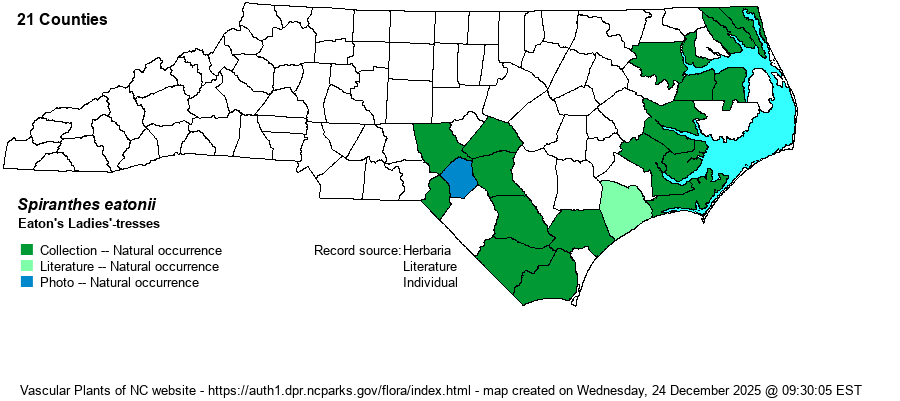| Author | Ames ex P.M. Brown | |
| Distribution | Found across the lower Coastal Plain, from VA to SC, inward sparingly into the Sandhills. Best known from the southeastern counties along the coast.
This species has a moderate range in the Southeast, from extreme southeastern VA south to southern FL to extreme eastern TX. It is easily overlooked or passed over as other species, and so the sparse number of counties showing on the BONAP map might not represent reality. | |
| Abundance | Rare to uncommon in a zone from Carteret County south to Brunswick County, but rare to rather rare elsewhere within its range. It is a small species of Spiranthes, easily passed over as some other species, which was the case when RAB (1968) was published; it simply was not recognized as being different from other species such as S. gracilis, S. praecox, or S. grayi. This uncertainty about its abundance is shown by the NatureServe giving it a G3? global rank. Surprisingly, it had been listed as State Endangered prior to May 2021, which seemed to be somewhat too high a conservation level, for a species known from at least 20 counties in the state. In May 2021, State listing was dropped, though it is tracked by the NCNHP as Significantly Rare. | |
| Habitat | This orchid is primarily found in pine savannas, but it is also found in pine flatwoods, at times where fairly dry. It tends to be found in well managed preserves, as it can be easily over-topped by taller vegetation if its habitat is not frequently burned. |
| Phenology | This is a spring bloomer, from February to May and early June. Most similar species tend to bloom somewhat later than this, and a few much later into the growing season. It fruits shortly after flowering. | |
| Identification | This is a somewhat "tiny" orchid and is certainly one of the smaller Spiranthes in stature. It often grows just 6-12 inches tall, with a few oblanceolate basal leaves that wither by the time it flowers. It normally has a single spiraling row/rank of white to creamy white flowers in the flower cluster; the spiral is not usually tight but is normally gradually curving. The lateral sepals and the petals have green at the bases and the lip also is either green or has green lines. Also, the lateral sepals are spatulate (rounded at the tip), whereas other similar species have these sepals acuminate and completely white. S. praecox can be similar and also blooms in the spring, but it has a taller stem with a longer flower cluster, more grass-like basal leaves (if visible), and the lip of the flower is not papillate (small projections or protuberances). S. eatonii does have such protuberances, but you will likely need a hand lens to see this. As indicated above, this species is not overly rare, at least in savannas, but when you see a ladies'-tresses in bloom in the spring, carefully check out the flowers, with a hand lens if you have one. | |
| Taxonomic Comments | Though it was not included in RAB (1968), this omission is simply owing to it being overlooked or called some other species. It is not a recent split, for example. The naming paper is by Brown (1999), which has a key and photographs.
| |
| Other Common Name(s) | None | |
| State Rank | S2 [S2S3] | |
| Global Rank | G3Q | |
| State Status | SR-P | |
| US Status | | |
| USACE-agcp | FACU link |
| USACE-emp | FACU link |

